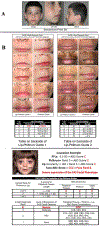High facial specificity and positive predictive value are required to diagnose fetal alcohol syndrome when prenatal alcohol exposure is unknown
- PMID: 37228766
- PMCID: PMC10208451
High facial specificity and positive predictive value are required to diagnose fetal alcohol syndrome when prenatal alcohol exposure is unknown
Abstract
Background: Facial criteria with high specificity and positive predictive value (PPV) to prenatal alcohol exposure (PAE) are required to diagnose fetal alcohol syndrome (FAS) when documentation of PAE is unavailable. Not all fetal alcohol spectrum disorder (FASD) diagnostic guidelines appear to meet these criteria.
Methods: A dataset generated from a 10-year FAS screening of 1,602 children in fostercare conducted by the University of Washington FAS Diagnostic & Prevention Network was used to determine how well the FAS facial phenotype, microcephaly and growth deficiency (individually and in combination at varying levels of magnitude) predicted PAE.
Results: The 4-Digit-Code Rank 4 FAS facial phenotype was the only outcome that provided sufficient PPV and specificity to PAE (100%) to allow the facial phenotype to serve as confirmation of PAE in a diagnostic setting when PAE is unknown. Even minimal relaxation of the phenotype (e.g., Face Rank 3) resulted in PPV (35%) and specificity (88.7%) values too low to use as confirmation of PAE. Further relaxation of the facial criteria, as defined by the Hoyme et al., 2016 FASD guidelines, resulted in even lower PPV (17.9%) and specificity (76.6%); both too low to serve as confirmation of PAE in a diagnostic setting. The presence of all three physical features of FAS (Hoyme et al FAS facial phenotype, growth and OFC ≤10th percentile) did not increase PPV beyond chance (52%).
Conclusions: FASD diagnostic guidelines that use relaxed criteria for the FAS facial phenotype risk misdiagnosing and over-diagnosing FAS and partial FAS when PAE is unknown.
Keywords: FAS facial phenotype; Fetal Alcohol Spectrum Disorder; Positive Predictive Value.
Conflict of interest statement
COMPETING INTERESTS The author does not have any competing interests.
Figures



Similar articles
-
Secondary physical features in children with FASD.Eur J Med Genet. 2024 Feb;67:104890. doi: 10.1016/j.ejmg.2023.104890. Epub 2023 Nov 30. Eur J Med Genet. 2024. PMID: 38042254 Free PMC article.
-
Comparison of the FASD 4-Digit Code and Hoyme et al. 2016 FASD diagnostic guidelines.Adv Pediatr Res. 2017;4(3):13. doi: 10.12715/apr.2017.4.13. Epub 2017 Oct 30. Adv Pediatr Res. 2017. PMID: 33409370 Free PMC article.
-
Comparison of the 4-digit diagnostic code and the Hoyme diagnostic guidelines for fetal alcohol spectrum disorders.Pediatrics. 2006 Oct;118(4):1532-45. doi: 10.1542/peds.2006-0577. Pediatrics. 2006. PMID: 17015544
-
A review of the physical features of the fetal alcohol spectrum disorders.Eur J Med Genet. 2017 Jan;60(1):55-64. doi: 10.1016/j.ejmg.2016.10.004. Epub 2016 Oct 10. Eur J Med Genet. 2017. PMID: 27729236 Review.
-
Diagnostic issues affecting the epidemiology of fetal alcohol spectrum disorders.J Popul Ther Clin Pharmacol. 2014;21(1):e153-8. J Popul Ther Clin Pharmacol. 2014. PMID: 24779084 Review.
Cited by
-
Fetal alcohol spectrum disorders and access to regional center services in San Diego County.Alcohol Clin Exp Res. 2022 Oct;46(10):1857-1864. doi: 10.1111/acer.14934. Epub 2022 Sep 14. Alcohol Clin Exp Res. 2022. PMID: 36059261 Free PMC article.
References
-
- Stratton K, Howe C, Battaglia F. Fetal Alcohol Syndrome: Diagnosis Epidemiology Prevention and Treatment. Institute of Medicine Washington D C National Academy Press; 1996.
-
- Astley S, Clarren S. Diagnosing the full spectrum of fetal alcohol exposed individuals: Introducing the 4-Digit Diagnostic Code. Alcohol Alcohol. 2000;35:400–10. - PubMed
-
- Astley S Diagnostic Guide for Fetal Alcohol Spectrum Disorders: The 4-Digit Diagnostic Code. 3rd ed. Seattle: University of Washington Publication Services; 2004.
-
- Bower C, Elliot E. Report to the Australian Government Department of Health: Australian Guide to the diagnosis of fetal alcohol spectrum disorder. In: Health AGDo, editor. 2016.
Grants and funding
LinkOut - more resources
Full Text Sources
Research Materials
Miscellaneous
